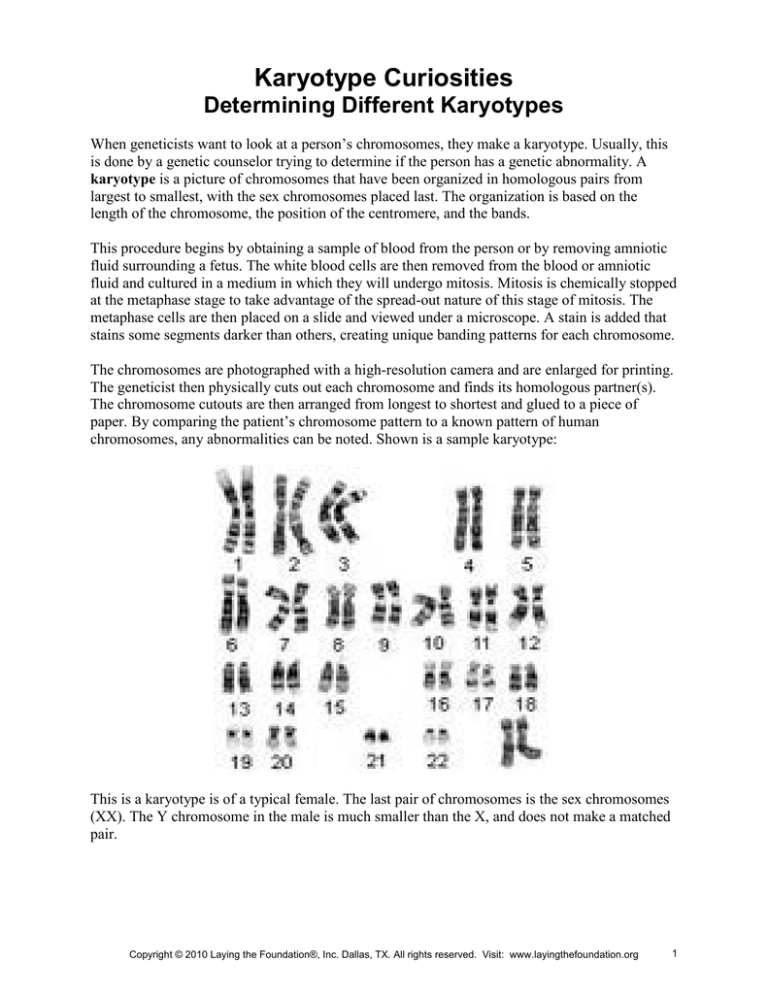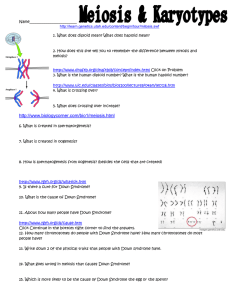
Karyotype Curiosities
Determining Different Karyotypes
When geneticists want to look at a person’s chromosomes, they make a karyotype. Usually, this
is done by a genetic counselor trying to determine if the person has a genetic abnormality. A
karyotype is a picture of chromosomes that have been organized in homologous pairs from
largest to smallest, with the sex chromosomes placed last. The organization is based on the
length of the chromosome, the position of the centromere, and the bands.
This procedure begins by obtaining a sample of blood from the person or by removing amniotic
fluid surrounding a fetus. The white blood cells are then removed from the blood or amniotic
fluid and cultured in a medium in which they will undergo mitosis. Mitosis is chemically stopped
at the metaphase stage to take advantage of the spread-out nature of this stage of mitosis. The
metaphase cells are then placed on a slide and viewed under a microscope. A stain is added that
stains some segments darker than others, creating unique banding patterns for each chromosome.
The chromosomes are photographed with a high-resolution camera and are enlarged for printing.
The geneticist then physically cuts out each chromosome and finds its homologous partner(s).
The chromosome cutouts are then arranged from longest to shortest and glued to a piece of
paper. By comparing the patient’s chromosome pattern to a known pattern of human
chromosomes, any abnormalities can be noted. Shown is a sample karyotype:
This is a karyotype is of a typical female. The last pair of chromosomes is the sex chromosomes
(XX). The Y chromosome in the male is much smaller than the X, and does not make a matched
pair.
Copyright © 2010 Laying the Foundation®, Inc. Dallas, TX. All rights reserved. Visit: www.layingthefoundation.org
1
PURPOSE
In this activity, you will analyze simulated karyotypes to determine the genetic syndrome
represented.
MATERIALS
copy of one of the 10 karyotypes
copy of the chromosome guide
copy of the syndrome inventory
scissors
glue sticks
PROCEDURE
1. Obtain the materials from your teacher.
2. Cut out the chromosomes and organize them:
a. Match homologous chromosomes by considering the length, similar bands, and position
of the centromere.
b. Arrange autosomal chromosomes from largest to smallest with the short arms up. Sex
chromosomes should be listed last.
3. Use the glue stick to adhere them to the paper.
4. Number the chromosome pairs.
5. Determine the syndrome of your karyotype, or determine if it is normal. Label it.
Copyright © 2010 Laying the Foundation®, Inc. Dallas, TX. All rights reserved. Visit: www.layingthefoundation.org
2
Copyright © 2010 Laying the Foundation®, Inc. Dallas, TX. All rights reserved. Visit: www.layingthefoundation.org
3
Syndrome Inventory for Karyotype Analysis
CRI DU CHAT SYNDROME
Cri du chat syndrome is caused by chromosome #5 having parts eliminated. The name means
“cat cry,” and it may have been based on the sound the infant makes who has this syndrome as it
is very high-pitched and sounds like a cat. It is a very rare disease that occurs in approximately
1 in 50,000 births. Symptoms include:
•
•
•
•
•
•
•
•
Severe mental retardation
Cry that is high pitched
Eyes slanted downward and wide-set
Low birth weight and slow growth
Partial webbing of fingers or toes
Abnormally shaped ears
Simian crease
Small head and jaw
PATAU SYNDROME
Patau syndrome is caused by an extra chromosome #13. Also known as Trisomy 13, its victims
rarely survive because of severe neurological and heart defects. It affects females more than
males, and is associated with increased age of the mother. Symptoms include:
•
•
•
•
•
Neurological problems like microcephaly and severe mental retardation
Facial defects
Polydactylism
Heart defects
Kidney defects
EDWARD’S SYNDROME
Edward’s syndrome is caused by an extra chromosome #18 and is also known as Trisomy 18. It
affects all systems of the body, and occurs in approximately 1 in 8000 births. It occurs more
often in females. Symptoms include:
•
•
•
•
•
•
•
Microcephaly
Small and wide-set eyes
Small lower jaw
Mental retardation
Seizures
Congenital heart defects
Severe growth retardation in bones
Copyright © 2010 Laying the Foundation®, Inc. Dallas, TX. All rights reserved. Visit: www.layingthefoundation.org
4
DOWN SYNDROME
Down syndrome is caused by an extra chromosome #21. It is associated with increased age of the
mother (over 40) and early age of the mother (under 16). It affects approximately 1 in 800 births,
and the victims of this disorder have many physical traits in common. Symptoms include:
•
•
•
•
•
•
•
•
Mild mental retardation
Short stature
Weak muscles
Short, stocky arms and legs
Simian crease
Small, low-set ears
Thick tongue
Flat nasal bridge
JACOB’S SYNDROME
Jacob’s syndrome is caused by an extra Y chromosome in a male. Most males with this
syndrome have normal sexual development and appear normal in other ways. This syndrome
used to be called the “criminal chromosome,” but there is no scientific evidence to indicate
antisocial behavior. This disorder occurs in approximately 1 in 850 males. Usually, a male does
not know that he has this condition unless a genetic test has been done for another reason.
Symptoms may include:
•
•
•
•
Tall stature
Severe acne
Large hands and feet
Increased testosterone levels
KLINEFELTER SYNDROME
Klinefelter syndrome occurs in males and is caused by an extra X chromosome. The XXY
arrangement occurs in about 1 in 1000 males. It may occur in females, where the result is the
female being transgender; however, there has been no scientific study done on this outcome.
Symptoms in males include:
•
•
•
•
Breast development
Sterility
Sparse facial and body hair
Rounded body type
Copyright © 2010 Laying the Foundation®, Inc. Dallas, TX. All rights reserved. Visit: www.layingthefoundation.org
5
TRISOMY X
Trisomy X occurs in females with an extra X chromosome. It is often not diagnosed until later in
life, as the symptoms are mild. Trisomy X occurs in about 1 in 1000 female births. Symptoms
include:
•
•
•
•
Tall stature
Learning disabilities
Speech and language delays
Delayed motor skills
TURNER SYNDROME
Turner syndrome occurs in females who have only one X chromosome. Most girls with this
syndrome have normal intelligence, with an occurrence in about 1 in 2500 girls. Symptoms
include:
•
•
•
•
•
•
Short stature
Sterility
Webbing of the neck
Skeletal abnormalities
Kidney problems
Heart defects
Copyright © 2010 Laying the Foundation®, Inc. Dallas, TX. All rights reserved. Visit: www.layingthefoundation.org
6
Copyright © 2010 Laying the Foundation®, Inc. Dallas, TX. All rights reserved. Visit: www.layingthefoundation.org
7
Copyright © 2010 Laying the Foundation®, Inc. Dallas, TX. All rights reserved. Visit: www.layingthefoundation.org
8
Copyright © 2010 Laying the Foundation®, Inc. Dallas, TX. All rights reserved. Visit: www.layingthefoundation.org
9
Copyright © 2010 Laying the Foundation®, Inc. Dallas, TX. All rights reserved. Visit: www.layingthefoundation.org
10
Copyright © 2010 Laying the Foundation®, Inc. Dallas, TX. All rights reserved. Visit: www.layingthefoundation.org
11
Copyright © 2010 Laying the Foundation®, Inc. Dallas, TX. All rights reserved. Visit: www.layingthefoundation.org
12
Copyright © 2010 Laying the Foundation®, Inc. Dallas, TX. All rights reserved. Visit: www.layingthefoundation.org
13
Copyright © 2010 Laying the Foundation®, Inc. Dallas, TX. All rights reserved. Visit: www.layingthefoundation.org
14
Copyright © 2010 Laying the Foundation®, Inc. Dallas, TX. All rights reserved. Visit: www.layingthefoundation.org
15
Copyright © 2010 Laying the Foundation®, Inc. Dallas, TX. All rights reserved. Visit: www.layingthefoundation.org
16
Karyotype Curiosities
Determining Different Karyotypes
DATA AND OBSERVATIONS
Use a sheet of blank paper for each karyotype. Staple your karyotypes to your student answer
page for submission.
CONCLUSION QUESTIONS
1. What genetic syndrome did your karyotype(s) have? Justify your answer.
2. Besides determining a genetic abnormality, for what else might a karyotype be used?
3. How might a karyotype be used unethically?
4. A is the allele for normal skin color, and a is the allele for albinism. C is the allele for normal
hemoglobin production, and c is the allele for sickle-cell anemia; E is the allele for normal
bone growth, and e is the allele for dwarfism. Describe the person with the alleles AAccEe.
Copyright © 2010 Laying the Foundation®, Inc. Dallas, TX. All rights reserved. Visit: www.layingthefoundation.org
17









